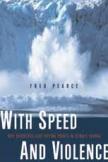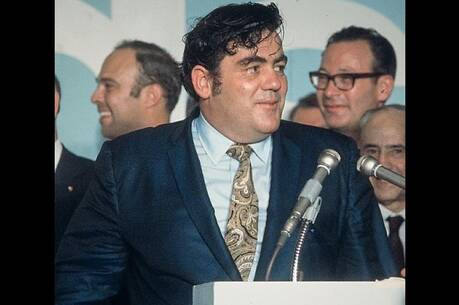Turning Up the Heat
In the face of massive disinformation about climate change, what is a citizen to do? Read With Speed and Violence.
Explaining potential catastrophes caused by climate change, the book opens with a look at the Greenland Sea, once home to at least 12 chimneys, or giant whirlpools. By 1997 warming Arctic waters had reduced the number to four. Now only one remains.
Six miles in diameter, the chimney continuously swirls water from the surface to the seabed miles below. That water will not return to the surface for a thousand years. Pursuing its lonely task, pushing aside a column of water a half-mile wide, the chimney is fed by icy polar waters. It may be the remaining switch that turns the world’s climate system on and off. After the waters of the Gulf Stream flow northward, bringing tropical Atlantic warmth, in the Greenland Sea they meet icy waters. The denser freezing waters sink, creating a massive swirl that is the critical starting point of the global ocean-circulation systemthe ocean conveyor. Passing south of Africa, around Antarctica, and through the Indian and Pacific Oceans before joining the Gulf Stream, the conveyor warms cold regions and promotes carbon-dioxide exchange between the atmosphere and the oceans.
Many scientists say the ice ages began when warm Arctic Ocean temperatures single-handedly shut down the conveyor, the Achilles Heel of the climate system. As With Speed and Violence makes clear, a similar shutdown seems imminent, permanently and irreversibly altering the world. Dublin would acquire a polar climate. London would become like Siberia. The North of the planet would freeze, while the South would grow even warmer.
As the declining number of ocean chimneys reveals, the most serious problem of climate change is not increased global warming but the violent disruption of normal weather cycles. The planet has already embarked on a roller-coaster ride of lurching and sometimes brutal change. Fred Pearce, the author of When the Rivers Run Dry, explains in this new book what that ride will be like.
If greenhouse-gas emissions continue to rise at the current rate, the planet will experience catastrophic change in less than 10 years. Many low-lying, inhabited islands in the Pacific Ocean will be gone by 2015. Absorbing more carbon dioxide, the author notes, the oceans may turn into a giant lifeless acid bath. Massive extinctions will take place, just as they did 55 million years ago, when ocean temperatures soared dramatically. More extreme weather events will occur, like the summer 2003 heat wave that caused 20,000 deaths in Italy and 15,000 deaths in France. As the Arizona desert creeps north, and as southern Europe’s climate becomes like that of North Africa, droughts will worsen. Within a century, many scientists say, Britain could be turned into a desert, and the Amazon rainforest could be gone. Already in the last 30 years, climate change has caused drought-stricken land areas to increase from 15 percent to 30 percent.
The culprit is both climate warming and smog. Fossil-fuel smog cripples atmospheric hydroxyl, nature’s detergent, so that it cannot oxidize and wash away pollutants. Smog also may shut down the Asian monsoons that are necessary to help feed much of the developing world.
Even insurers are worried. Extrapolating from recent insurance claims, they say that by the year 2060, losses from droughts, hurricanes, tsunamis, landslides, forest fires and other weather-related events will exceed total global economic activity. Pearce forecasts that unless something changes soon, this will be the last generation that can rely on anything close to a stable global climate in which to conduct our affairs. Disrupting the carbon cycle on which life depends, this bonfire of fossil fuels has driven greenhouse-gas concentrations to their highest levels in millions of years.
One result is El Niño events (reversals of ocean currents, winds and weather systems across the Pacific Ocean). Another result is that in the last 30 years, the frequency of the worst hurricanes (categories 4 and 5) has doubled. In a single day, the average hurricane can now unleash energy that is equivalent to a million Hiroshima bombs. Warmer oceans allow hurricanes to take up more water and increase in size and intensity. A pre-eminent U.S. climate scientist, James Hansen, says, We are on the precipice of climate-system tipping points beyond which there is no redemption.
Are he and Pearce right? For at least 15 years scientific journals have documented a clear scientific consensus that climate change is real and preventablea consensus muddied by fossil-fuel interests. For the last five years, scientists have agreed that climate change is likely to be catastrophic, not smooth or gradual.
Enhancing his credibility, Pearce even-handedly explains the minor details on which some climate scientists disagree. He uses up-to-date science, explains difficult concepts in accurate, entertaining ways and includes a scientific glossary. The result is a gripping, highly readable bookperhaps the best discussion of climate change for lay readers.
Readers who may not see climate change as a moral and theological issue should remember that it is fundamentally about equity. Poor nations have done the least to cause climate change yet will be harmed most, because they lack the economic resources to respond to it. Rich nations, especially the United States, have done the most to cause climate change yet have done the least to correct it. The United States and Australia emit about 5.5 tons of carbon each year for every citizen, while European nations emit less than 3.3 tons, China less than 1.1 tons and India less than half a ton. Yet the United States and Australia are the only developed nations that have not signed the Kyoto Protocols to reduce fossil-fuel use.
The Book of Revelation talks of Armageddon, the place where the final battle will be fought between the forces of good and evil. Climate change may create the global Armageddon.
This article also appeared in print, under the headline “Turning Up the Heat,” in the April 30, 2007, issue.








